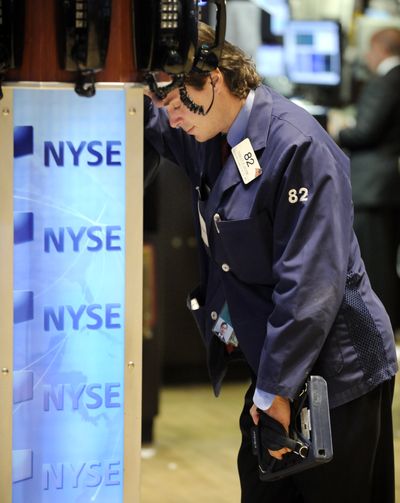Financial chaos spreads
Erratic Dow industrials at 4-year low; fears mount throughout Europe, Asia

WASHINGTON – The government’s $700 billion rescue, aimed at rebuilding economic confidence, appeared to sound a global alarm instead on Monday, triggering a fearful international sell-off as the U.S. began work on a plan that investors feared would be too little and too late to stave off a worldwide recession.
As markets around the world tumbled amid fast-spreading anxiety, officials in Washington worked quickly to put the new financial plan into effect and to shovel more money into the banking system.
The Treasury Department named a former Goldman Sachs executive, Neel Kashkari, now Treasury’s assistant secretary for international affairs, to oversee the new program and said it would increase its bond sales to help pay for the huge package that was approved with fanfare and signed Friday by President Bush.
Trying to do its part, the Federal Reserve increased a short-term loan program to as much as $900 billion and announced it would begin paying interest on reserves that banks keep with it.
Bush sought to reassure panicking markets. “It’s going to take awhile to restore confidence in the financial system. But one thing people can be certain of is that the bill I signed is a big step toward solving this problem,” he said in San Antonio, Texas.
Nobody seemed reassured. Chaos in the financial system seemed to be growing by the minute.
The Dow industrials plunged below the 10,000 level for the first time in four years, and at one point were down as much as 800 points before recovering to close with a loss of 370. All sectors – not just financial companies – were being sold off.
“People are panicked that their bank is going to go out of business. People have just lost a lot of trust in the financial system and in these large institutions,” said Anil Kashyap, professor of economics and finance at the University of Chicago’s Graduate School of Business. He suggested the crisis has morphed from a near shutdown in lending to a new, more dangerous phase in which financial and other companies face greater chances of insolvency.
The fear was reinforced by new problems among European banks and fresh worries in Asia of a spreading global recession that would harm the continent’s prized ability to export.
Gone are Wall Street investment banks Bear Stearns and Lehman Brothers. Merrill Lynch gave itself up in a fire sale to Bank of America. Washington Mutual ceased to exist, and Wachovia, once the nation’s fourth largest bank, is being acquired – either by Wells Fargo or Citigroup. American International Group, one of the world’s largest insurers, is struggling after a big loan from the government kept it from collapsing. Mortgage giants Fannie Mae and Freddie Mac have been essentially taken over by the government.
Some top economists seemed at a loss for ways to stop the downward spiral.
“I think what’s needed is a global rate cut. But even that I don’t think would solve the basic problem, which is that everybody’s just scared of loaning money to anybody else,” said David Wyss, chief economist for Standard and Poors in New York.
Pressure was growing on the Fed and other major central banks to band together and announce a global interest-rate cut.
Many believe the Fed will ratchet down a key lending rate to banks – now at 2 percent. In turn, the prime lending rate – now at 5 percent – for certain credit cards, home equity lines of credit and many other consumer and business loans – would drop by a corresponding amount.
Some believe rates could be slashed soon by as much as a full percentage point to 1 percent in hopes of encouraging people and businesses to spend more, thereby restoring confidence to the system.
Others, however, are skeptical.
Even if borrowing costs were to decline, that doesn’t mean banks would be more inclined to lend more freely.
“You can bring the horse to water, but you can’t make him drink,” said Richard Yamarone, economist at Argus Research. “The panic has so intensified that no matter what the Fed or Treasury throws at it, it may be ineffective. It can be hard to slay the dragon of fear when it takes over the market.”
Rob Shapiro, who was an economic adviser to President Clinton, said the crisis in Europe will turn out to be at least as severe as it is in the United States. “Between Europe and the United States, we’ll take everybody else with us. And this is reflected in the markets,” he said.
Shapiro, who heads the global initiative program at NDN, a Washington think tank, said one step that might help restore confidence would be for the government to set up a program to make direct loans to people facing foreclosures. Another might be for the government to turn all the problem mortgages held by Fannie Mae and Freddie Mac into 30-year fixed rate ones.